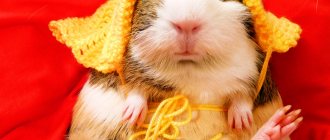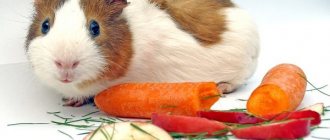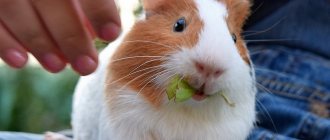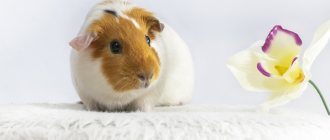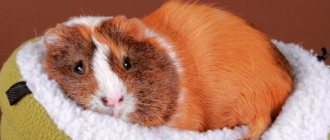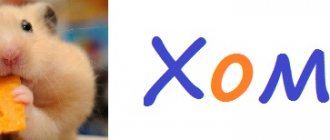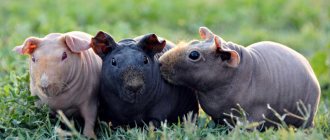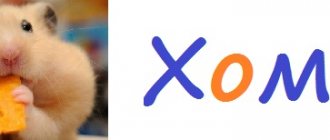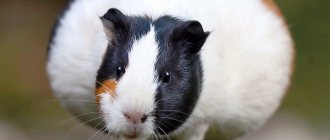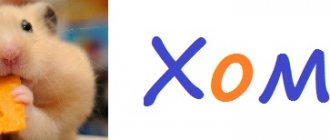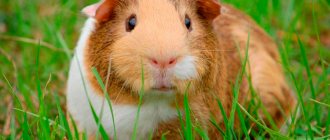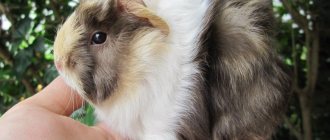- home
- Guinea pig
- Guinea pig breeds
02/19/2019 Long-haired guinea pigs are popular as pets due to their beautiful, silky coat. They have special needs regarding grooming. If these needs are ignored, pets will lose their healthy and beautiful appearance and will begin to get sick. Studying detailed information about keeping and caring for the animal will help the owner take proper care of it.
Description and appearance
The long-haired guinea pig was bred for decorative purposes: for home keeping and participation in competitions and exhibitions. All wild ancestors of the animal have short hair.
The body of a long-haired pig is the same in parameters as other varieties: oval body, short neck, rounded muzzle. The ears are “envelope-shaped” - slightly drooping. The paws are short, with 4 toes on the front and 3 on the hind. The length of the body and weight vary from breed to breed, but on average they are 25-35 cm and 1-1.2 kg.
The pet's coat grows up to 50 cm. There are both solid colors and multi-colored ones. The most common color is red in different shades. The rarest is tortoiseshell. Exclusive colors are obtained after crossing a large number of animals (100 or more individuals) belonging to the same breed.
Among the long-haired pigs there are pigs with straight, curly, wavy strands. The presence and location of rosettes, partings, direction of hair growth, etc. vary.
Lifespan
Depending on the conditions of detention, pigs live on average about 5 years. Under favorable conditions, an age of 7-8 years is possible. If a healthy pedigree is added to this, the pet will live up to 10 years.
Shorthair breeds
The second name for this large group of rodents is smooth-haired. Representatives of this population can most often be found among ordinary people; animals are no less popular in scientific circles, where they are used as experimental animals.
All breeds in this category are characterized by the presence of smooth, even coat; the hairs fit tightly to the body. According to the type of color, they are divided into plain and variegated.
- Ordinary. In appearance it resembles a ball, it is so compact and stocky. The eyes are round, large, and black. The ears are set wide apart, hang down, and have no hair. The color can be any, mainly spots of black, white, and red are scattered throughout the body. There are also single-colored individuals.
- Self. Characterized by uniform coloring of the entire fur coat. At the same time, there can be a great variety of color variations: albino, black, gold, red, cream, saffron, purple. Eye color - black or red. The hair grows back, the “hairstyle” is always neat, like a real English queen.
- Satin, in other words - satin. The charm and beauty of these pigs lies in the incredible shine of their hair, which is especially pronounced in the spotlight or in the sun. In principle, this type can be classified in the previous group of monochromatic ones, because the difference lies only in the structure of the hair - in “satin” it is hollow inside, which is why it shimmers in bright light.
- Russians. Sometimes pigs are also called Himalayan, although they have nothing to do with the Himalayas and were bred in our country. The peculiarity of the “piglets” is their snow-white body with black (chocolate) paws, ears and muzzle. This coloring appears well in cool climates, but if the ambient temperature is too high, the pigment will lighten and the animal will be completely white.
- Motley. Not one breed, but includes several.
- Dutch. It is distinguished by its unusual color, characterized by the presence of dark spots on the cheeks and the back half of the body. In this case, the white spot on the muzzle should have the shape of a regular wedge. The Dutch weigh slightly less than their relatives, have a soft, easy-going character and get along well with children.
- Agouti. The most common species are golden and silver. There are also chocolate, cream and brown. Each hair is divided into three color zones, while the abdomen is monochromatic. The breed is considered one of the hardiest and most prolific. By the way, there is an opinion that agouti are the progenitors of all currently available breeds of pigs.
- Speckled. Alternating black and red stripes throughout the fur coat. The latter look like spots with a clear separation boundary. Sometimes there are variations of the three-stripe color, when white is also added.
- Tortoiseshell. The presence of clear spots of black, red and white colors, alternating in a special order. At the same time, the fur coat looks like a patchwork quilt or even a chessboard. By the way, in Russia these rodents are often called “cakes”, which is similar to the English name of the breed - torty&white.
Keeping and caring for a long-haired guinea pig
Pigs have a calm and friendly character, but it is better not to have them in a family where there are preschool children: children do not always calculate their strength correctly and are capable of accidentally causing harm to the pet. But for children of primary and secondary school age, pets are quite suitable. You should also carefully introduce the rodent to dogs, cats and other pets. Depending on each pet's personality, they may be reluctant to get along with each other. Guinea pigs are often purchased in pairs (of the same or different sexes) so that they do not get bored in the absence of the owner. They get along well with each other.
Buy a cage that is spacious and roomy. The appropriate size for one pig is 60x40x60 cm. The home is located away from windows, balconies, radiators and doors to avoid drafts and direct sunlight. Pets are sensitive to temperature changes: it should be kept in the range of 18-22 degrees.
These rodents are easily injured when falling, so the cage should be one-story or include one additional low floor. Required equipment for the cage:
- Bowl;
- drinker (preferably ball);
- feeder or manger for hay and grass;
- toilet tray;
- mineral stones or twigs for grinding teeth;
- house (placed on the lower tier).
The floor of the cage is sprinkled with sawdust or filler. If the pet is litter box trained, it is enough to change the bedding once a week, and if not, 2-3 times. In addition, bowls and drinking bowls must be washed daily.
It is not recommended to keep your pet in a cage all the time. At least several times a week, he is allowed to run around the floor, having previously removed dangerous or necessary things from the access area: wires, books, indoor plants, clothes.
Wirehaired pigs
Their second common name is rosette. The wool is hard to the touch and should form rosettes, with the hair in it spreading from the center of the circle to its circumference.
All “piglets” in this category are characterized by a quarrelsome character, as well as the ability to live in a cool climate. For example, in Europe, many owners keep their pets outside all year round.
The most ancient representative of the group is the Abyssinian guinea pig, which is also called Japanese. The hair should stick out in all directions, be very stiff, no more than 3 cm long. In this case, the rosettes are distributed evenly over the entire surface of the skin and in no case should merge with each other.
The color can be mottled (alternating red and black hair), tortoiseshell or plain.
Feeding
Pigs eat plant foods. Their diet contains both dry food and succulent food. There should be more of the latter, but not too much, otherwise it will lead to diarrhea. Juicy foods include grass, greens, and vegetables. Sometimes fruits or berries are offered in small quantities as a treat. A variety of vegetables are offered. A large amount of one product will lead to negative results. For example, too much white cabbage will cause flatulence in your pig. Feeding is carried out at the same time, because The animal’s gastrointestinal tract needs regular portions of new food, which “moves” the previous one through the intestines. The pet may die if it does not receive food within 18 hours.
Pigs, like other rodents, periodically eat their own excrement. This is due to the fact that vitamins K and B remain in the primary, soft feces, which are necessary for maintaining health. Therefore, it is better not to purchase a cage with a special tray. This is convenient in terms of hygiene - long hair gets dirty less, but then the pet will not be able to take doses of natural vitamins and will have to buy them additionally at the pharmacy.
The pig's water is changed every day. Use filtered or boiled at room temperature. Cold water leads to colds or pneumonia. On average, a pet drinks up to 80 ml of water per day. If your pig drinks little, most likely she needs enough fluid from succulent food.
Research and conclusions
In the city of Kemerovo, hobbyists keep single specimens of long-haired pigs, the origin of which is unknown; semi-long-haired individuals are found in huge numbers, but it makes no sense to consider their exterior in this topic. Therefore, we will consider the best guinea pigs of the Peruvian breed, kept in the corner of nature of GorSYUN, where there is the largest population of purebred animals in the city. The origin of almost all the animals from “Fauna” is known, and many carry the blood of European champions.
Hygiene and grooming
Owners of long-haired pigs pay a lot of attention to hair care. Your pet should be brushed daily with a soft brush. This prevents the formation of mats and some skin parasites. During combing, the hairs are saturated with oxygen, which makes the fur look shiny and well-groomed. In addition, the process of combing calms the pet and brings him pleasure.
It is better to cut off the resulting tangles, because... unraveling will cause unnecessary anxiety for both the owner and the animal. Many pigs do not like water treatments. If the pet gets dirty, do not bathe it, but carefully wash the stained area, then dry it with a towel and then with a hairdryer at low power.
If there is no need or desire to leave long hair, it can be trimmed regularly, especially in the summer - this will keep the pet cooler and more comfortable. Or at least trim the bangs above the eyes so that the pig can see better and not spoil his vision. Wearers who like long locks use small elastic bands, clips or curling irons to hold their hair together, avoiding tangles and messes. In addition, this makes it easier for the animals to move around.
In addition to the fur, it is necessary to take care of your pet’s claws and ears. Growing claws are regularly trimmed with scissors or a special nail clipper. The ears are cleaned with cotton swabs, first lightly moistened in vegetable oil - to prevent infections.
Sheltie
The Sheltie guinea pig was obtained by crossing the American and Peruvian breeds. The Sheltie has a straight, long coat, but the main difference is the direction the coat grows from the head to the back.
A special feature of Sheltie pets is their lush mane, which hangs around the animal’s body. Shelties have different colors. It has a dense body, a wide head, a short nose, large and bulging eyes, and slightly drooping ears. The Sheltie's temperament is playful and calm.
Pet health
The animals have strong immunity, so infectious diseases rarely bother them. They usually appear if the pet often walks outside or if one of the household, including other animals, gets sick. Common infectious diseases include:
- skin infections;
- salmonellosis;
- toxoplasmosis;
- ringworm;
- coccidiosis.
In addition, a pet can be harmed by physical injury or a violation of the diet: spoiled or poisonous foods, intolerance (allergy) to some component. In this case, cystitis, conjunctivitis, and neoplasms are possible. Foods prohibited for pigs include:
- dairy products;
- products of animal origin;
- sweets;
- flour;
- cooked food from the common table.
The first sign that your pet is feeling unwell is a decrease in appetite or refusal to eat. In such cases, you should find out the reason for this behavior as soon as possible and take action. Prolonged hunger strikes lead to exhaustion of the body and worsening of the disease.
Characteristics of the animal
The first mentions of the super-hairy pig date back to the 19th century. Their distinctive appearance feature is long and very thick, even hair all over their body. On the head they fall forward, covering the animal’s muzzle; on the body they are evenly parted in the middle of the back.
Even parting along the entire length
But really, the Peruvian guinea pig, the photo of which is above, is just a copy of the wig.
The remaining characteristics are more familiar:
- Life expectancy is about 5 years;
- Body length – up to 30 cm, no tail;
- Weight – up to one and a half kilograms;
- The body is short, stocky, muscles are highly developed;
- The eyes are large and glare strongly in the light;
- The colors are very varied.
Individual of three colors
Keeping a pig at home
Because of their silky fur, Peruvian guinea pigs depend on human care to a much greater extent than, for example, a simple Djungarian hamster. It is not recommended to have them for children as a “toy”, or for elderly people. This breed of guinea pig was bred for exhibitions and is more decorative than a pet.
The pig made friends with the cat
But, nevertheless, no one forbids buying them as a pet; in fact, they are also a full-fledged animal, which is no stranger to playing, being pampered, loving and being loved not only in a social circle, but also in ordinary working families.
If you do not plan to show the animal at exhibitions, then you can trim the hair in front of the eyes.
Buying a cage
Before buying an animal, you need to buy and prepare a cage in which it will live. The cage should have a lot of toys, ladders, and small houses. The wheel is not necessary - if they use it, it will be very little.
Pig cage
The dimensions of the cage should be approximately 80x80 cm, and a height of at least 50 cm. If Peruvian guinea pigs receive full care for their fur, but at the same time live without games in a boring cage, then the animal can still get sick.
If it is not possible to equip their house according to these rules (the cage is small, or they were simply allowed to keep it while the owners are on vacation), then they must let the pet run around the apartment for at least half an hour every day. But only under your close supervision, otherwise you will spend half a day looking for her, and when you find her, she will be covered in dust and scared.
We buy a Peruvian pig
As a rule, it is better to purchase exotic, rare and expensive pets in specialized nurseries. The Peruvian guinea pig is no exception; you can buy it second-hand, but where are the guarantees:
- That she is not sick;
- All necessary vaccinations are available;
- There is reliable information about her parents;
- What is this Peruvian pig?
It’s better to overpay a little, but your soul will be at peace, especially since the prices for this breed of guinea pigs are not that high - around 4,000 rubles.
Choosing a pig in a nursery
And you can contact the nursery for help throughout the animal’s life, which cannot be said about private sellers.
Reproduction
Pigs reach sexual maturity at 2-3 months. At this age they are able to reproduce. Repeated mating is possible just a day after the last birth. But from a health point of view, such sexual activity does not lead to positive consequences. Early pregnancy in pets causes complications and health problems in females. Therefore, it is recommended to arrange the first birth no earlier than 5-6 months of life. In addition, it is recommended to arrange pregnancy no more than twice a year. And in males, frequent sexual intercourse leads to infertility.
Parents must not be closely related. This circumstance increases the risk of genetic diseases in offspring. For the purity of the breed, it is better if the adult pigs belong to the same species and are the same age.
During the first birth, the female often gives birth to only one large cub. The average number of fruits is 2-4, medium in size. Pregnancy lasts 10 weeks. Small animals are born sighted and fully formed. The mother chews the amniotic sac and licks the babies dry. It is better not to leave animals unattended at this time in case of an emergency. The owner must be prepared to wipe the cubs himself if the female for some reason does not do this.
If everything went well, half an hour after giving birth, the female drinks plenty of water (the owner takes care of a sufficient amount of liquid in advance) and begins feeding the offspring. Cubs feed on milk for the first three months of life, but are able to consume regular food 1-2 days after birth.
Conditions of detention
Pigs are sociable and usually get along well with other pets. They are often bred in pairs (preferably same-sex ones if there is no intention of breeding).
A large cage (suitable size for one individual is 60-40-60 cm) with a slatted floor is suitable for keeping - so that waste falls into the tray and does not stain the wool. Dirt constantly sticks to the long fur, so cleaning should be done as often as possible - 4-5 times a week. Wood filler or sawdust is used as bedding.
The pet can be trained to go to a specially designated place when needed (a tray with sawdust in the corner of the cage). In this case, it is enough to thoroughly clean the cage once a week.
Long haired guinea pig price
The average price of a pig starts from 1000-1500 rubles. The following factors influence the cost of a pet:
- floor;
- age;
- breed;
- pedigree;
- region;
- class of animal (for keeping, breeding or exhibitions).
Animals are purchased at pet stores, from breeders or online. Each method has risks and benefits. In a pet store, it is convenient to immediately purchase the necessary supplies with your pet: a cage, drinking bowls, food. Breeders guarantee health and provide a detailed pedigree of the animal. In addition, they give advice on the correct content. Purchasing on the Internet turns out to be the most budget-friendly way, since pets are often given away for free or for a nominal fee. For example, in case of allergies, a sudden move, or if you need to give away cubs.
Albinos and dwarf pigs
There are many myths that albinos have poor health and are rejected from many breeds. This statement is wrong. An albino is a guinea pig with pink or blue eyes and a complete absence of coloring pigment. In many breeds, albinos are bred and recognized as distinct color forms. Thus, albinos are quite common among Selfies, Himalayans, and Teddies. A white guinea pig with pink eyes can be either a Texle or an Agouti.
The only thing that can affect the health of albino animals is inbreeding in pursuit of fixing eye color, especially if they are blue.
The second myth concerns the existence of dwarf guinea pigs. Cavias are not dwarf. There are some breeds that are slightly smaller in size. These breeds include Dutch pigs or Teddies. In some litters you can find smaller cubs, which are characterized by slower growth and even as adults remain much smaller than their counterparts. In this case, it is worth talking not about dwarfism, but about the fact that a genetic deviation and developmental delay have occurred. Such cavy cannot be used for further breeding.
Teddy guinea pig breed
Owner reviews
Experienced pig owners often share tips and tricks for caring for their pets. Many people warn that it costs about 1.5-2 thousand rubles per month to maintain an animal, not counting visits to the veterinarian, if such are required. The pet will need bedding material, dry food and vegetables. The latter are given cut into large pieces so that the animal can grind down its incisors while feeding.
Trimming nails requires care and patience - not all pets like this procedure. In some cases, the help of a second person is needed to firmly hold the struggling animal. Additionally, use coarse material for bedding or let the pig run around more often so that the claws wear down naturally. Overgrown claws prevent the pet from moving and deform the feet.
You need to be prepared that pigs, especially long-haired ones kept indoors, shed all year round. Therefore, you will have to not only clean your pet’s cage, but also regularly clean clothes and furniture.
Introduction
In recent years, it has become fashionable to purchase various animals for apartment keeping, which, it would seem, can be positive for the development of an environmentally friendly society, but in the absence of experience and free time it leads to the fact that the pet, despite the “honest” care of the owner, is not comfortable.
I would like to have a beautiful, tame, affectionate animal and take care of it in my free moments.
The ideal companion for very busy and always free people, children and adults, is the Peruvian long-haired guinea pig. The animals are very affectionate, with a rich sound repertoire.
This breed is a wonderful work of art of many generations of breeders, has a unique breed appearance, and is very easy to keep [2].
Pigs of this breed were brought to Russia in the last century; the centers of their selection were and remain Moscow and Lipetsk; there are a small number of good nurseries in St. Petersburg [2].
Angoras were repeatedly brought to the city of Kemerovo, but no serious selection was carried out. As a result, we find the “long-haired” gene in many local individuals, and true breed specimens are rare[2].
There is no literature clearly stating the standard in Russia, but the leading breeders in our country have a very clear idea of the breed. The presented report is an analysis of domestic literature and literature translated into Russian, information received from nursery owners, long-term observations of Peruvian long-haired guinea pigs in the creative association of the GorSYUN "Fauna" based on school No. 92 in Kemerovo.
Purpose: To study the features of the exterior and behavior of the Peruvian long-haired guinea pig, based on the information received, to give recommendations on the maintenance of this breed.
Tasks:
- Get a clear idea of the current state of the breed and trends in its development.
- Outline the behavioral characteristics of the breed.
- Based on the knowledge gained, make recommendations for the care and maintenance of the Peruvian long-haired guinea pig.
Source
Breeds of pigs with long hair
Varieties of long-haired animals differ in the quality of their fur and such features as the number of rosettes, the location of the parting, and the length of the bangs.
Angora breed
Angora pets are distinguished by their strong, muscular bodies and stocky necks. The fur is soft and silky, reaches 15-20 cm in length and evenly covers the entire body. Some individuals have small rosettes near the nostrils. The presence of tanks, a narrowed spout and an asymmetrical shape of sockets are considered unacceptable.
Peruvian breed
The Peruvian pig is one of the oldest varieties of these animals. The first mentions of it date back to the mid-19th century. Features of the breed: long, straight hair that evenly covers the body, including the head. In everyday life, animals have a tail on their heads so they can see.
Other distinctive features of Peruvian pigs, established by the breed standard in 1930:
- even parting along the back;
- two irregularly shaped rosettes in the sacrum area are a sign of a pure breed;
- presence of thick undercoat.
Alpaca guinea pigs
The ancestors of the animal were Peruvian pigs and rexes. According to breed standards, it resembles the Peruvian variety:
- presence of undercoat;
- Evenly long hair over the entire body.
The main difference is that alpaca wool, when it grows to a certain length, begins to curl. The length of the strands is shorter - up to 30 cm, versus 50 cm for the Peruvians. The fur grows at a rate of 2.5 cm per month. Rare and expensive colors are silver, golden and tortoiseshell.
Guinea pigs coronet
Coronets are bred by crossing Shelties and Cresteds. The breed was officially registered in 1995, although it appeared earlier. The body of the coronet is shorter than that of other varieties. The coat is thick and straight, with an even train and a “ridge” along the back. Distinctive feature: a small rosette on the top of the head. The breed standard allows for different colors.
Pig Lunkaria
It first appeared in 1986 as a result of a random mutation. Lunkaria pigs have an unusual shape and texture of their coat: twisted and tangled curls, as if they have been styled with hairspray. The coat cannot be straightened or thoroughly combed. Features include two rosettes in the croup area and the absence of partings.
Merino
English pig, born as a result of crossing the Texel and Coronet breeds. It has long curly hair that makes it look like a sheep. The breed is young and not officially registered. There is currently no standard.
Texel guinea pig
Texels stand out among long-haired species because of their curls. Their ancestors were Rex and Sheltie. The breed was officially recognized in 1998. The animals have expressive sideburns hanging down the sides of their heads and a hump on their nose. Texels do not require daily combing, but before participating in the exhibition, the coat is combed, trying to prevent the formation of curls. The average hair length is 12-18 cm, different colors are allowed.
Skinny
These pigs of truly exotic appearance appeared as a result of a mutation in 1978 at the Institute of Montreal (Canada). They have no fur, only on the nose and paws there are sparse curly and coarse hairs. Skinny skin is very soft and velvety. The most common color is chocolate; there are black, tortoiseshell, silver, lilac, etc.
Skinnies have an excellent appetite, which is not surprising: they have a faster metabolism, as they need to retain body heat. Therefore, they eat 3 times more than their furry counterparts, sometimes gnawing on something all day long.
Due to their lack of fur, skinnies require a little more care and attention than regular guinea pigs. The main thing that future owners of these cute and gentle creatures need to know is that skinnies need to be protected from drafts and always kept warm. If fasting days are only beneficial for most animals, then for skinnies to remain for two days without food is literally like death. At the same time, skinnies are prone to obesity, so the owner’s task is to carefully consider the diet, establish a diet and strictly adhere to it.
Baldwins
Unlike Skinnies, who have tufts of hair on their paws and nose, Baldwins are a completely hairless breed. Babies are born covered with fur, like ordinary pigs, but by the age of one month it completely falls out. Baldwins have extremely delicate skin; both cold and direct sunlight are dangerous for it.
A person who has decided to get a guinea pig and has become acquainted with all the variety of breeds faces a difficult question: how to choose “your breed” among all this diversity?
Surely, many people want to have a rare breed of pig at home. Thus, hairless guinea pigs are very in demand and popular today. But here you need to take into account that these are more delicate and sensitive animals, they are more demanding in terms of care and living conditions. And the price for such exotics will be significantly higher than for pigs of less rare breeds. In addition, when purchasing a pig of a rare breed with a good pedigree, additional responsibility is imposed on the owner: you need to join a club, take part in exhibitions, find your pet the most suitable partner for mating, etc.
Pigs of less rare breeds can be no less beautiful and affectionate pets. Short-haired guinea pigs are easier to care for, they have high immunity, which means they get sick much less often than other breeds of pigs. Animals with short hair are the best choice for a novice breeder. In addition, if you are purchasing a guinea pig for a child, it is best to choose just such a pet. Caring for rosette pigs is also not very difficult, but they are somewhat more expensive. As for guinea pigs of long-haired breeds, they need more thorough coat care, which will require much more time.
- Guinea pig and...
- Why sea...
- Toys for…
- Guinea pig care
- How to choose and...
- Where and when is best...
